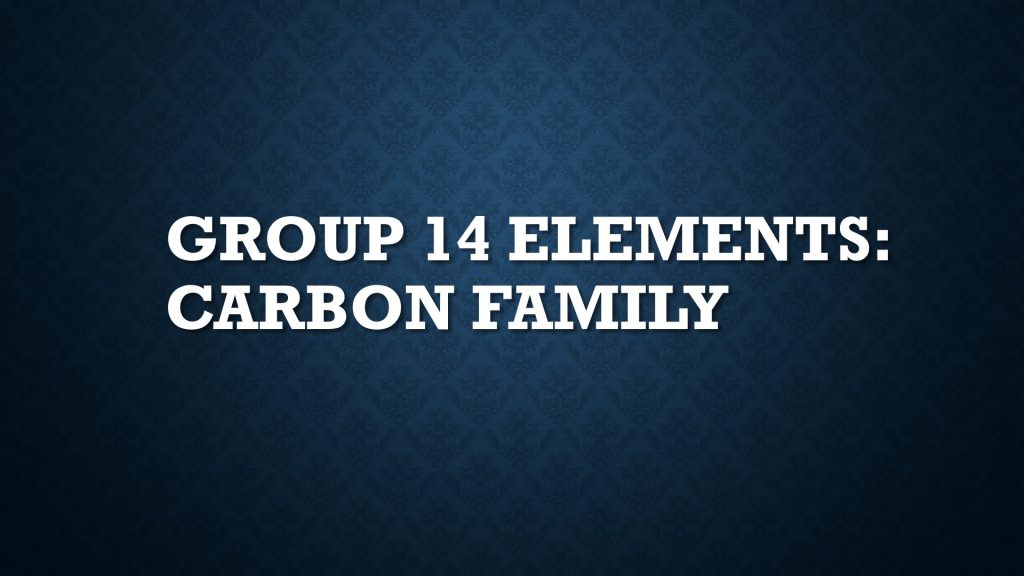Group 14 Elements also known as Carbon Family belongs to the p-block group in the modern periodic table developed by Dmitri Mendeleev. Group 14 consists of elements,Carbon(C), Silicon(Si), Germanium(Ge), Tin(Sn), Lead(Pb), and Flerovium(Fl).

Index
History
Carbon, tin, and lead are a few of the elements well known in the ancient world.
Silicon as silica in the form of rock crystal was familiar to the Predynastic Egyptians, to the Chinese and probably to many others of the ancients.
Germanium was first predicted by Dmitri Mendeleev in 1869, when he first devised the periodic table.
In September 1885, a miner discovered a mineral sample in a silver mine and gave it to the mine manager, who determined that it was a new mineral and sent the mineral to Clemens A. Winkler. Winkler realized that the sample was 75% silver, 18% sulfur, and 7% of an undiscovered element. After several months, Winkler isolated the element and determined that it was element 32(Germanium).
In 1969, an attempt was made to discover Flerovium at the Joint Institute for Nuclear Research, but was unsuccessful. In 1977, the researchers at the institute made another attempt by trying to bombard plutonium-244 atoms with calcium-48. This attempt was unsuccessful too. The nuclear reaction was repeated in 1998, this time successfully.
The Group 14 Elements or Carbon Family
The group 14 was also once known as Tetrels. Tetrels derived from the Greek word, tetra, which means four. This was derived from the fact that these elements have four valence electrons.
| Properties | Carbon | Silicon | Germanium | Tin | Lead | Flerovium |
| Atomic Symbol | C | Si | Ge | Sn | Pb | Fl |
| Atomic Number | 6 | 14 | 32 | 50 | 82 | 114 |
| Atomic Mass(amu) | 12.011 | 28.08 | 72.61 | 118.71 | 207.8 | 289 (unconfirmed) |
| Valence Electronic Configuration | [He]2s22p2 | [Ne]3s23p2 | [Ar]3d104s24p2 | [Kr]4d105s25p2 | [Xe]4f145d106s26p2 | [Rn]5f146d107s27p2 |
| Atomic Radii(pm) | 77 | 111 | 122 | 140 | 175 | 180 (predicted) |
| Melting Point/Boiling Point(K) | – | 1687/3538 | 1211.40/3106 | 505.08/2875 | 600.61/2022 | 200/380 (predicted) |
| Density(g cm3) | 1.8-3.5 | 2.33 | 5.323 | 7.265 | 11.34 | 9.93 (predicted) |
| First Ionization Energy/kJ mol-1 | 1086.5 | 786.5 | 762 | 708.6 | 715.6 | 832.2 (predicted) |
| Common Oxidation State(s) | −4, −3, −2, −1, 0, +1, +2, +3, +4 | −4, −3, −2, −1, 0, +1, +2, +3, +4 | −4 −3, −2, −1, 0, +1, +2, +3, +4 | −4, −3, −2, −1, 0, +1, +2, +3, +4 | −4, −2, −1, +1, +2, +3, +4 | (0), (+1), (+2), (+4), (+6) (predicted) |
| Electronegativity | 2.55 | 1.90 | 2.01 | 1.96 | 1.87 |
Trends in Group 14 Elements
- Electronic Configuration
- Members of the group 14 have a general electron configuration ns2np2. They have 4 electrons in their outermost orbit.
- Atomic Radii
- The atomic radii of group 14 increases down the group with increase in the number of orbits.
- Ionisation Enthalpy
- Moving down the group, we notice that the ionization enthalpies decrease. This is because of the increase in the distance from the nucleus.
- There is a substantial decrease of ionization enthalpy from carbon to silicon. Post that, the difference is less considerable.
- There is a slight increase in ionization enthalpy from tin to lead due to the poor shielding effect of the d and f orbitals.
- Electronegativity
- As we move down the group, the electronegativity decreases in general. The reason behind this irregularity is because of the filling of intervening d and f atomic orbitals. However, the electronegativity is almost the same from silicon to lead.
- Reactivity of Elements
- The reactivity of the elements in group 14 decreases down the group. It happens that the inert pair effect is becoming increasingly effective by moving down the group.
- The stability of the state of +4 is decreased whereas the +2 oxidation state is increased on moving down the group.
Anomalous Behaviour of Carbon
Carbon exhibits different behaviour from the rest of the group due to,
- Small Size
- High Electronegativity
- High Ionization Enthalpy
- Absence of d-orbital in the Valence shell
Applications of Group 14 Elements
- Carbon has many applications. Carbon is used for steelmaking, as a filling in tires, in respirators, used as lead in pencils in the graphite form.
- Diamond, another form of carbon, is commonly used in jewellery.
- Silicon is used as toothpaste, as a major component of glass in the form of silica. Silicon is also commonly used in semiconductors.
- Germanium is used in radiation detectors, fibre optics and wide-angle camera lenses.
- Solder is an important use of tin. Tin is also used in tin plates.
- Lead is used in lead-acid batteries. It is used in shielding against radioactive materials. Lead was historically used in gasoline in the form of tetraethyllead but was discontinued due to concerns of toxicity.
More on P Block
